Best Spare Parts & Inventory Management Software
We reviewed the best parts inventory software for manufacturers and maintenance organizations. We based our rankings on features like real time stock tracking and automated reordering to help you optimize inventory distribution.
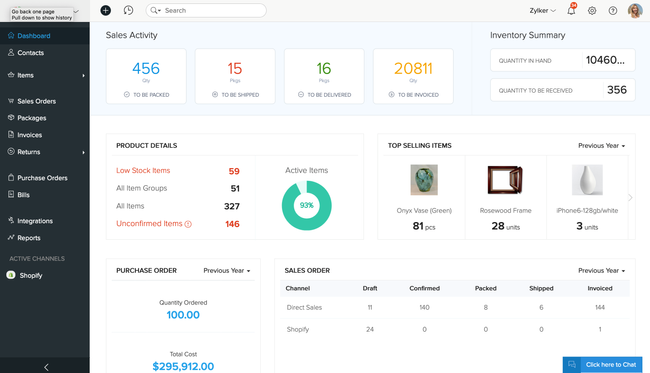
- Simple interface
- iOS and Android apps
- Wide variety of add-ons
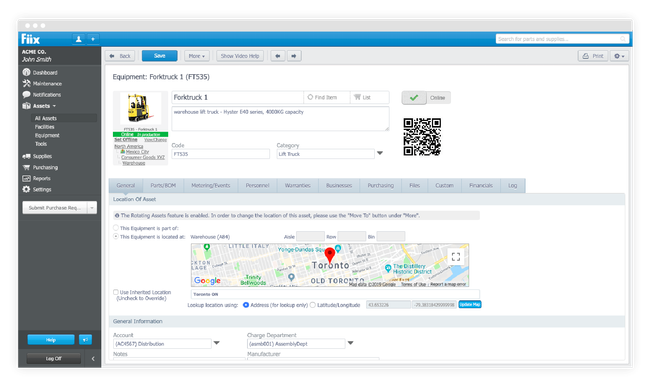
- Has a forever-free version
- Very easy to create and add new items
- Mobile accessibility
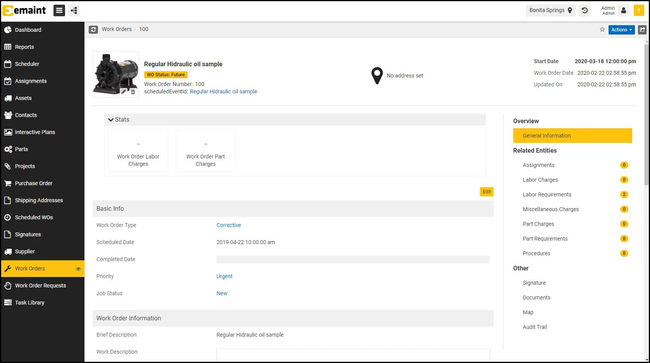
- Offline mode with work order syncing capabilities
- Customizable KPIs
- Strong international support: multi-currency, multilingual, multi-location, etc
Using our review methodology, we’ve evaluated the best spare parts inventory systems based on real-world usability, feature depth, and industry fit. Each tool below earned its place by excelling in specific areas like procurement, maintenance tracking, customization, or ease of use.
- Zoho Inventory: Best Procurement Tools
- Fiix CMMS: Best Preventative Maintenance Tools
- eMaint CMMS: Best for Manufacturers
- Acctivate: Best for QuickBooks Users
- UpKeep: Most User-Friendly Pick
- FMX: Strong Facility Management
- Sortly: Great Asset Tracking
- Fishbowl Inventory: Most Customizable Option
- Click Maint: Best for Education
Zoho Inventory - Best Procurement Tools
Zoho Inventory offers advanced procurement management and replenishment features that streamline acquiring spare parts and other inventory. These tools integrate with Zoho Inventory’s system modules, such as sales, inventory, and accounting.
The system maintains optimal stock levels by automating the ordering process. When stock items reach predefined reorder points, it automatically generates purchase orders and sends them to designated suppliers, reducing the risk of stockouts and production delays. It can also place orders for multiple items simultaneously, streamlining the procurement process and allowing you to save time and reduce manual errors.
The system easily creates and manages purchase orders, monitors their status, and receives notifications about supplier confirmations. This level of organization not only enhances communication with suppliers but also maintains detailed records of supplier information, including contact information, payment terms, and order history.
Fiix CMMS - Best Preventative Maintenance Tools
Fiix CMMS offers strong preventative maintenance tools that establish a framework for proactive maintenance management. In Fiix CMMS, you can set up schedules based on manufacturer recommendations, historical data, or usage patterns. The system will automatically generate work orders and send alerts to maintenance personnel, detailing what needs to be done and when.
As tasks are completed, your staff can log the work done, update inventory levels if parts were used, and provide feedback on equipment performance in the system. This data collection allows for reporting and trend analysis to inform future maintenance decisions.
eMaint CMMS - Best for Manufacturers
eMaint CMMS is best for manufacturers because it offers tools to track assets, implement preventive maintenance, and optimize inventory. This makes it a valuable asset for manufacturers aiming to minimize costs related to parts management. eMaint’s proprietary sensors add an extra layer of functionality, beneficial for larger businesses in the manufacturing sector.
The user-friendly interface is accessible to maintenance managers and teams, allowing them to visualize maintenance asset location data on floor plans, schematics, or site maps. Customization options make eMaint an ideal choice for mid-market and enterprise-level organizations seeking efficient spare parts management and overall maintenance optimization.
Acctivate - Best for QuickBooks Users
Acctivate is designed for growing distributors, manufacturers, and online retailers using QuickBooks. In fact, Acctivate’s integration with QuickBooks Desktop is a significant advantage, ensuring seamless financial reporting and inventory accuracy.
Acctivate offers a wealth of features and add-ons that can be tailored to meet the specific needs of businesses looking to optimize spare parts management. Features such as mobile warehouse management, barcoding, traceability, and order fulfillment make it possible to efficiently manage spare parts inventory.
UpKeep - Most User-Friendly Pick
UpKeep is a CMMS which offers a user-friendly interface for managing spare parts. With a mobile app that offers real-time work requests, preventive maintenance scheduling, and QR code functionality, UpKeep is well-suited for organizations aiming to streamline maintenance processes.
A key feature for parts management is streamlined communication with maintenance technicians. UpKeep provides companies that require real-time access to work orders a way to coordinate maintenance activities across multiple locations. The software’s compatibility with both iOS and Android devices ensures flexibility and accessibility for all team members. Additionally, the incorporation of QR codes for asset tracking simplifies maintenance check-ins and updates on-site, enhancing efficiency.
FMX - Strong Facility Management
FMX offers a compelling choice for businesses seeking spare parts management software within a facility management context. It provides a comprehensive solution for facilities managers, particularly in industries like manufacturing, property management, education, and more. The software’s low stock alerts, incoming shipment notifications, and custom alerts are valuable tools for ensuring timely reordering of supplies and monitoring inventory expirations.
One of FMX’s notable features is its ability to track inventory and equipment histories, making it an ideal choice for businesses looking to manage spare parts efficiently. All this makes FMX an attractive solution for businesses seeking efficient spare parts management within the broader context of facility management.
Sortly - Great Asset Tracking
Sortly is a cloud-based inventory management software particularly well-suited for tracking assets such as tools, machinery, equipment, and vehicles. Its intuitive interface and features for customizing tags, generating QR codes and barcodes, and labeling items make it easy for users to get started with inventory management.
Sortly is especially recommended for small businesses and startups seeking straightforward inventory management solutions.
Fishbowl Inventory - Most Customizable Option
Fishbowl Inventory offers a customized platform for teams managing spare parts for equipment repairs, product assembly, or facility maintenance. Users can create custom tracking labels for each spare part, such as assigned serial numbers or job-specific usage tags, to better track what parts are used for.
Once labels are assigned, Fishbowl monitors how often parts are used, their costs, and current stock levels. This helps teams analyze usage trends, automate recording, and minimize inventory waste. Custom role-based dashboards also give purchasing and inventory teams different views from technicians using the parts, enabling them to focus on what tasks are most important to them.
Fishbowl’s modular design allows teams to start with basic inventory management and then expand into areas like manufacturing inventory, warehousing, or barcoding as needs evolve. One drawback is that the basic version only includes a limited amount of serial number tracking. So teams managing large volumes of serialized inventory may need to upgrade to the advanced plans. Pricing starts at around $3,200 per year for a limited user package.
Click Maint - Best for Education
Click Maint’s inventory management module can help schools consolidate their inventory. It includes stock level tracking to ensure you maintain proper amounts. These can be for facility spare parts, like HVAC, plumbing, and electrical systems. This helps ensure maintenance departments can repair breakdowns and fix issues immediately without having to wait for a part reorder.
The module also includes barcode and QR Code scanning through the mobile app. Technicians can scan items to receive or issue them for work orders, which automatically adjusts stock counts. This helps improve accuracy by reducing manual data entry. And when items pass the minimum threshold, it will instantly notify you to reorder.
Click Maint is one of the more affordable systems on the list, with a starting price of $35/user/month. Its plan comes with every feature, as opposed to the tiered pricing plans found in other CMMS software like UpKeep.
What is Spare Parts Inventory Management Software?
Spare parts inventory management software, often shortened to parts management systems, helps businesses monitor and control the components they rely on for manufacturing, maintenance, and repair operations. These systems go beyond basic inventory tracking by supporting real-time stock visibility, automated reordering, and usage monitoring tied to specific assets or work orders. Spare parts systems are often added onto existing maintenance management software.
You may need spare parts for:
- Product assembly
- Vehicle repair and maintenance
- Machine and equipment repairs
Whether your spare parts are for a warehouse or an auto repair garage, software can make it easier to optimize your inventory levels.
How to Choose Spare Parts Software
Prioritize spare parts inventory management software that streamlines inventory management and supports maintenance activities. Look for features like these:
Inventory Management
- Real-Time Inventory Tracking: Ability to track parts in real-time to avoid overstocking or stockouts.
- Barcoding and RFID Integration: For quick scanning and identification of parts.
- Multi-location Management: If you have multiple storage locations, the software should manage inventory across all these sites effectively.
Order Management
- Automated Reordering: Feature for setting reorder points that automatically trigger purchase orders.
- Supplier Management: Tools to manage supplier information, order history, and performance.
Parts Cataloguing
- Detailed Parts Database: A comprehensive database with detailed information about each part, such as part numbers, descriptions, specifications, and images.
- Search Functionality: Easy search options to quickly find parts based on various criteria.
Maintenance Scheduling and Tracking
- Preventive Maintenance Scheduling: Schedule and track regular maintenance activities to prevent equipment breakdown.
- Maintenance History Records: Maintain records of all maintenance activities performed, including parts used.
Reporting and Analytics
- Customizable Reports: Generate reports for inventory levels, order history, maintenance schedules, etc.
- Analytics Tools: Analyze data for trends and insights to make informed decisions about inventory levels, procurement, and maintenance.
Integration Capabilities
- ERP and CRM Integration: Seamless integration with existing ERP (Enterprise Resource Planning) and CRM (Customer Relationship Management) systems.
- Accounting Software Compatibility: Ability to integrate with accounting software for accurate financial tracking.
Mobile Accessibility
Mobile app or mobile-friendly interface for accessing the system remotely.
User-Friendly Interface
- Intuitive Design: Easy-to-navigate interface that reduces the learning curve for new users.
- Customizable Dashboard: Personalize the dashboard to highlight key metrics and data.
Workflow Automation
Streamline common processes like order approvals, returns, and maintenance requests.
Compliance and Auditing:
- Audit Trails: Keep records of all transactions and changes for auditing purposes.
- Compliance Management: Ensure that the management of parts complies with industry regulations and standards.
Key Features
- Parts profile: Store information on a part’s manufacturer, make, model, style, and other identifying features for future reference; record the part’s current location, minimum/maximum unit price, and available vendors
- Stock count tracking: Provides a record of the on-hand units for each SKU and helps maintain accurate stock levels through automated cycle counts
- Minimum stock quantities: Set an alert to automatically reorder when stock levels reach a predetermined minimum to avoid running low on parts; send email or push notifications when stock is low
- Inventory costing: Establish the cost value of assets for profitability tracking and tax accounting; potential cost methods include: FIFO, LIFO, and more
- Inventory receipts and tickets: Use receipts for inbound stock and ticketing for marking outbound parts
- Purchase orders and requests: Build a database with all your purchase orders
- Vendor tracking: Keep up-to-date records on vendors and suppliers of your business, along with their pricing data, to know who to contact for specific parts
- Work order records: Create a trackable document identifying what parts are needed for work that needs to be done from a Bill of Materials (BOM) and what parts are currently in stock
- Location tracking: Automate picking, packing, and shipping tasks related to inventory items by keeping real-time records on stock locations; Improve inventory loss prevention by keeping tabs on the movement of individual units
- Serial number, lot number, barcode, and RFID tracking: Identify particular units and track them using the preferred method of your facility, whether it’s scanning printed barcodes, QR codes, or using Radio Frequency Identification (RFID) readers to send radio waves and interpret the corresponding frequencies into inventory data
- Reporting: Use historical data on stock levels and usage rates to better inform your future decision-making when it comes to reordering spare parts
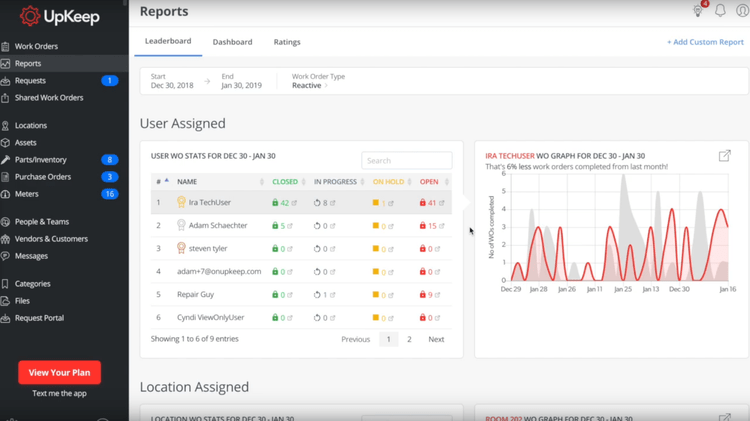
Top Benefits
Implementing software to manage your inventory can make your job easier in a lot of ways:
Real-Time Inventory Updates
Right now, you might be relying on Excel spreadsheets to track inventory. You might even have a physical checklist on a clipboard showing inventory levels. You deserve a better system, one capable of optimizing your asset management system.
Spare parts management software can do that, using real-time tracking tools such as custom QR codes and barcodes to count stock, set reorder points, and prevent overstock.
Along with real-time location data, you can look at the past of your assets as well. Movement histories can create a trail of how batches or individual parts move through your facility. This information can indicate exactly where each item should be and, more importantly, who was last in control of the missing parts.
Stay Ahead on Preventive Maintenance
Preventive maintenance can lead to a lot of cost savings for your business by reducing the likelihood of complete equipment breakdowns or extended downtime from waiting for replacement parts to arrive. Combined with parts management, you can streamline your maintenance operations by knowing exactly which assets are on hand and which ones are needed according to a bill of materials.
Knowing which spare parts you have in stock can allow your maintenance team to plan out their next repairs without running low on supplies. For example, a factory can use real-time inventory counts to see if anything is overstocked, and then begin using those excess spare parts to make preventative maintenance repairs.
Additionally, spare parts management systems can be paired with computerized maintenance management software (CMMS) to streamline your maintenance department’s repair schedule of machinery and equipment.
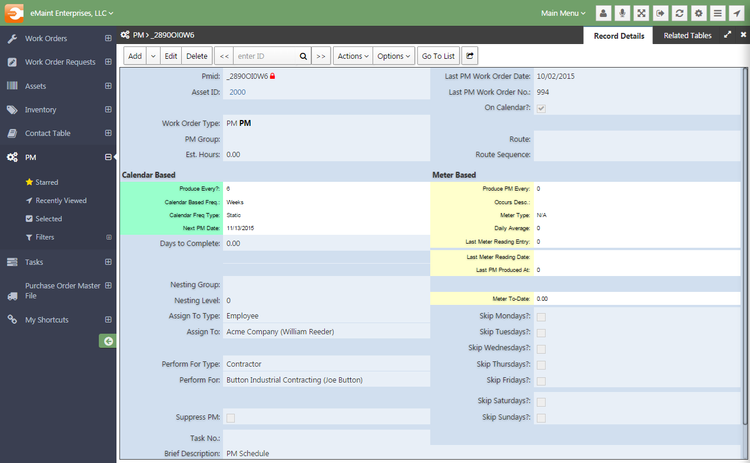
Reduce Loss and Duplicates
Parts loss can happen for a variety of reasons. A piece might break and get thrown out without the system being updated. Employee theft can account for loss as well. Sometimes a part simply gets misplaced.
With a spare parts inventory control system, you can minimize theft and loss by increasing visibility of real-time stock counts to see exactly when parts go missing in the system.
Have you ever ordered an out-of-stock part only to find you still have a few units on hand? The cost of these duplicate reorders can add up, leaving you with extra stock and less storage space. And historical data gathered by cycle counts can reveal when certain assets tend to sell the most, allowing you to plan ahead.
Trends in Spare Part Inventory Management
Parts inventory management has had many changes over the years. From handwritten notes to Excel spreadsheets, businesses of all sizes are always seeking ways to better track inventory. One recent advancement is the inclusion of mobile apps into inventory management systems.
Apps can be used on multiple mobile devices for increased freedom while tracking inventory. For instance, most warehouses rely on third-party hardware, such as handheld scanners or barcode readers, to scan items into the system. These pieces of hardware can be costly and require replacement every few years to stay up-to-date. With mobile apps, a warehouse manager with an iOS or Android smartphone can simply use their own phone to track inventory.
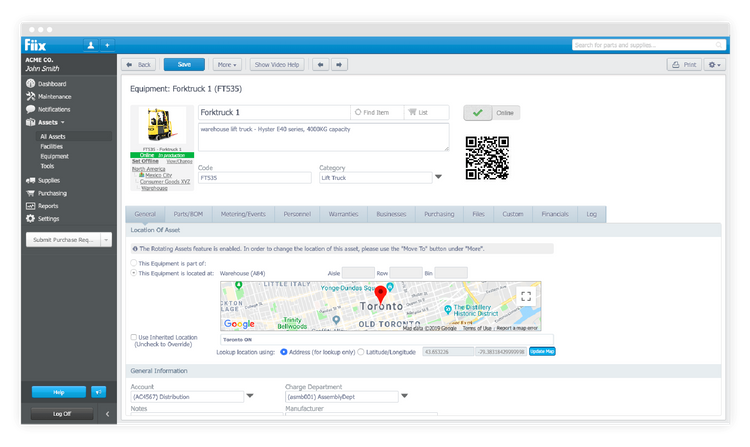
Pricing
Spare parts inventory software costs vary based on functionality, user count, and whether it’s part of a broader system like CMMS or ERP system. Systems focused only on part tracking and recording are more affordable, while platforms with maintenance automation, reporting, and integrations cost more.
For CMMS systems like eMaint or Click Maint, prices can range from $16-$120/user/month. These platforms are built primarily for maintenance management, and inventory tracking is found on advanced plans or as an add-on.
For full inventory management systems, which offer deeper tracking, forecasting, and automation tools, annual pricing generally ranges from:
- Low Range: $2,000 to $6,000 per year
- Mid Range: $10,000 to $30,000 per year
- High Range: $50,000 to $100,000 per year
- Enterprise Range: $150,000+ per year
Warehouse Management Software Costs
Some warehouse management applications include spare parts tracking alongside broader inventory and logistics features. These systems tend to be more expensive than standalone parts software and may be overkill if you’re only looking to manage internal stock and reorders.
Is There Free Software?
Free spare parts inventory management software is available, though it often limits users, features, and the number of tracked SKUs. Excel is always a free option but lacks integrations and automations with existing technology like WMS, CMMS, and ERP software.





































































